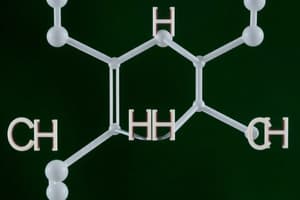Podcast
Questions and Answers
What distinguishes metamerism from other types of isomerism?
What distinguishes metamerism from other types of isomerism?
Metamerism involves compounds with the same functional group but different carbon skeletons.
How do tautomers differ from regular structural isomers?
How do tautomers differ from regular structural isomers?
Tautomers exist in rapid equilibrium involving the migration of atoms, such as keto-enol shifts.
Define configurational isomers and how they can be separated.
Define configurational isomers and how they can be separated.
Configurational isomers are those that cannot interconvert without breaking a covalent bond and can be separated under normal conditions.
What are stereoisomers and how are they classified?
What are stereoisomers and how are they classified?
Explain the difference between open-chain and cyclic compounds with an example.
Explain the difference between open-chain and cyclic compounds with an example.
What factors influence the angle of rotation (α) in polarimetry?
What factors influence the angle of rotation (α) in polarimetry?
How does the presence of a plane of symmetry affect the chirality of a molecule?
How does the presence of a plane of symmetry affect the chirality of a molecule?
Explain the relationship between chirality and optical activity.
Explain the relationship between chirality and optical activity.
Identify examples of chiral and achiral objects and explain their significance.
Identify examples of chiral and achiral objects and explain their significance.
What is enantiomerism and how is it determined in a molecule?
What is enantiomerism and how is it determined in a molecule?
Flashcards are hidden until you start studying
Study Notes
Isomers
- Metamerism is a type of isomerism where compounds have the same functional groups but different alkyl groups attached to the functional group. Examples include diethyl ketone and methyl n-propyl ketone.
- Tautomerism is a type of isomerism where compounds exist in equilibrium by migration of a hydrogen atom and a double bond. Keto-enol tautomerism is a common example.
Stereoisomers
- Stereoisomers have the same molecular formula and connectivity but differ in the spatial arrangement of atoms. They cannot be interchanged without breaking a bond.
- Configurational isomers are stereoisomers where interconversion requires breaking a bond. They can be separated under normal conditions.
- Conformational isomers are stereoisomers that can be interconverted by rotation about single bonds without breaking any bonds.
- Optical activity refers to the ability of a compound to rotate the plane of polarized light.
- Optical rotation (α) is the angle by which the plane of polarized light is rotated. It depends on the nature of the substance, concentration, length of the polarimeter tube, wavelength of light, and temperature.
- Chiral molecules are non-superimposable on their mirror image.
- Molecules with a plane of symmetry are achiral, meaning they are superimposable on their mirror image, and thus optically inactive.
- Enantiomers are non-superimposable mirror images of each other. They possess opposite optical rotations (+ and - forms) and are chiral.
- Diastereomers are stereoisomers that are not mirror images of each other. They may or may not be chiral and differ in physical properties such as melting point, boiling point, and solubility.
- R,S configuration is a system for naming enantiomers based on the priority of substituents attached to a chiral center. It is a more unambiguous system than the D,L system.
- Asymmetric synthesis refers to the synthesis of an optically active compound from an achiral compound using a chiral reagent or catalyst. The chiral reagent or catalyst directs the reaction to favor the formation of one enantiomer over the other.
- Stereochemical reactions involve the formation or breaking of bonds at a chiral center.
- Retention refers to a reaction where the configuration of a chiral center remains the same.
- Inversion refers to a reaction where the configuration of a chiral center is inverted.
- Racemization refers to a reaction that produces a racemic mixture, which is a 50:50 mixture of two enantiomers.
Studying That Suits You
Use AI to generate personalized quizzes and flashcards to suit your learning preferences.




